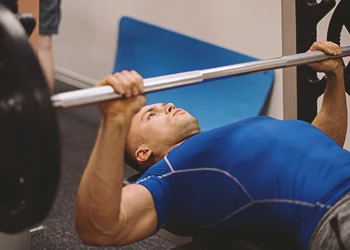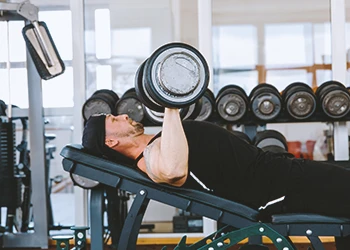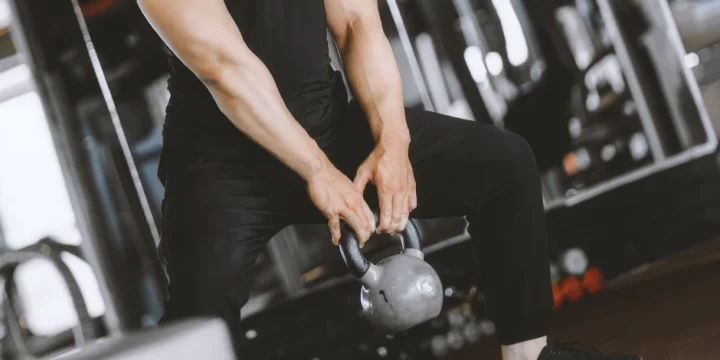Recently, I stumbled upon a workout routine called the PHUL program, which stands for Power Hypertrophy Upper Lower.
This training approach effectively targets major muscle groups with a combination of two upper-body and two lower-body workouts.
Each session alternates between power-focused exercises to enhance strength and hypertrophy-focused exercises to stimulate muscle growth.
As a personal trainer, I dedicated several weeks to testing the effectiveness of the PHUL workout program, delving into the scientific principles behind it. In light of my findings, I have crafted a sample PHUL workout routine that you can implement to optimize your muscle gains.
Quick Summary
- The Power Hypertrophy Upper Lower (PHUL) workout program combines main compound exercises such as bench press, squat, and deadlift with isolation exercises, structured into a weekly routine of four training days split between two days each of power and strength training.
- Your upper body training days will concentrate on the chest, back, shoulders, biceps, and triceps, while your lower body training days will primarily strengthen the quadriceps, hamstrings, calves, glutes, and part of the lower back.
- In this routine, perform 3–4 sets of 3-5 reps at 80–95% of your 1RM for strength-focused compound lifts, and 3–4 sets of 10-15 reps at 60–80% of your 1RM on hypertrophy days.
- In my opinion, the PHUL program primarily focuses on enhancing performance in essential compound lifts and maximizing muscle growth to achieve substantial overall strength and size gains.
PHUL Workout Routine

Start with a five to ten-minute dynamic warm-up to enhance your physical performance and prevent injury risk.
For the weight selection in this workout routine, aim for three to four sets of three to five reps using 80-95% of your one rep max for compound lifts on strength days and three to four sets of ten to fifteen reps using 60-80% of your one rep max on hypertrophy days.
As a personal trainer, I advise my clients to take up to two minutes of rest between exercises, tailoring the rest time to the intensity and challenge of each exercise.
In the PHUL program I use with clients, the training days are adaptable, so we can rearrange the workout sequence to fit their schedules.
Moreover, if a client misses a session, like the lower body hypertrophy workout, I recommend shifting it to the next available day, such as Saturday.
Monday - Upper Power

- Bench press: 3-4 sets x 3-5 reps
- Barbell row: 3-4 sets x 3-5 reps
- Incline dumbbell press: 3-4 sets x 6-10 reps
- Pull up: 3-4 sets x 6-10 reps
- Overhead press: 2-3 sets x 5-8 reps
- EZ bar curl: 2-3 sets x 5-8 reps
- Skull crushers: 2-3 sets x 8-12 reps
“Some people find it easier to do lying triceps extensions with a barbell rather than a dumbbell. However, using a barbell (even an EZ curl bar) does put more strain on the wrists, so keep this in mind. You may want to strengthen your wrists before using a barbell.”
- Paul Rogers, Personal Trainer
Tuesday - Lower Power
- Squat: 3-4 sets x 3-5 reps
- Deadlift: 3-4 sets x 3-5 reps
- Bulgarian split squat: 3-4 sets x 6-10 reps
- Leg press: 3-4 sets x 10-15 reps
- Hamstring curls: 3-4 sets x 6-10 reps
- Standing calf raise: 3-4 sets x 6-10 reps
Wednesday - Rest Day
Training consumes glycogen levels, an energy source stored in muscles, resulting in muscle fatigue.
According to the National Institute of Health (NIH), rest days allow the muscles to refill their glycogen stores, reduce fatigue, and prepare them for the next workout [1].
“To determine when you should rest, consider the recommendations for aerobic activity. Each week, adults should get 150 to 300 minutes of moderate activity or 75 to 150 minutes of vigorous activity. You can also do a combination of moderate and vigorous activity.”
- Kristen Nunez
Thursday - Upper Body Hypertrophy Day

- Incline dumbbell press: 3-4 sets x 8-12 reps
- Seated cable row: 3-4 sets x 8-12 reps
- Pec deck: 3-4 sets x 8-12 reps
- Bent-over row: 3-4 x 8-12 reps
- Keeling lateral raise: 3-4 sets x 8-12 reps
- Seated incline curl: 3-4 sets - 8-12 reps
- Cable tricep extension: 3-4 sets x 8-12 reps
Friday - Lower Hypertrophy
- Dumbbell lunge: 3-4 sets x 8-12 reps
- Leg press: 3-4 sets x 8-12 reps
- Leg extension: 3-4 sets x 8-12 reps
- Hamstring curl: 3-4 sets x 8-12 reps
- Romanian deadlift: 3-4 sets x 10-15 reps
- Calf press: 3-4 sets x 6-10 reps
- Standing calf raise: 3-4 sets x 6-10 reps
“Control the tempo of the exercise to see the full benefits of standing calf raises. Performing the movement too quickly isn’t as effective–at least in the beginning. It’s best to raise and lower your heels slowly to see increased strength and aesthetic improvement.”
- Chelsea Evers
Saturday - Rest Day or Active Rest Day (ARD)
If you feel like moving on your rest day, you may consider taking an active rest day, a day of gentle forms of exercises like walking or yoga proven to help reduce the build-up of lactate in the blood and prevent muscle fatigue.
You can also incorporate abdominal exercises into your workout routine on this day.
What Are the Benefits of a PHUL Workout Split?

As a trainer working closely with my clients, I've observed that a PHUL workout split significantly enhances their power, accelerates muscle protein synthesis, shortens workout duration, boosts recovery, and notably improves athletic performance.
Let's take a look at these benefits:
- Increased Power and Strength - The primary objective of the PHUL workout program is to enhance power and increase muscle size. Although the program includes specific hypertrophy-focused days, muscle building is still emphasized throughout the training. Research by the NIH has shown that lower reps with heavier weights (4 x 3-5) are just as adequate as higher reps with lighter weights (4 x 8–12) for muscle development [2].
- Shortened workout length - When following PHUL workouts with shorter rep ranges, you may complete approximately twenty sets within a single gym session, taking around an hour to complete.
- Accelerated muscle growth - Unlike other training programs that focus on working each muscle group only once a week, the 4-day PHUL workout program targets each muscle group twice a week. According to the NIH, this approach has resulted in faster muscle gains [3].
- Elevated muscle protein synthesis - Research from the National Library of Medicine (NLM) has confirmed that intense resistance training significantly and rapidly increases muscle protein synthesis. It has been concluded that muscle protein synthesis can more than double within twenty-four hours after a challenging workout [4].
- Enhanced recovery - The rest periods recommended in the PHUL workout program range from two to three minutes between each set. Numerous studies from NLM have shown that long rest periods (two to three minutes) are more effective for promoting muscle growth and strength gains than shorter rest periods of sixty seconds or less [5, 6].
- Maximized post-workout recovery - With PHUL, you can work your major muscle groups twice a week, striking a balance that avoids overtraining while still pushing your limits during each session.
- Varied workout routine - One of the benefits of PHUL over other training methods, like the 5×5 workout, is that you get to incorporate a wide range of exercises. Research by the NIH shows that mixing up your training stimulates more muscle faster [7].
- Improved athletic performance - Heavy strength training enhances athletic performance across multiple parameters. Research from NLM indicates that beginners, in particular, experience notable improvements in power measures, including jump height and sprint speed [8,9].
Related Articles:
Tips to Maximize Your PHUL Routine

To maximize your strength and hypertrophy workouts:
- Progressive overload - Once you have become accustomed to lifting a particular weight for the desired number of repetitions, it's time to progress. You achieve this by increasing the weight for your next workout. Typically, this involves adding a small amount of weight, such as 2.5 kg to each side. As you work your way back up to your target number of reps, maintain good form throughout each set.
- Track your progress - Monitoring your progress is crucial when starting the PHUL workout program or any other training method to evaluate its effectiveness and ensure your stay on track. Various online workout trackers allow you to log the sets, reps, and weights and easily assess if the training program is helping you accomplish the desired results or if adjustments are necessary to push yourself further.
- Keep good form - It's essential to prioritize the correct technique throughout your exercises. Only consider increasing the weight when you can complete all repetitions well. By focusing on proper form, you ensure that your muscles are appropriately activated and prevent the risk of injury.
- Include a healthy diet - Ensure you consume an adequate amount of protein to optimize protein synthesis during your recovery period. Research has indicated that regardless of gender or the amount of active muscle mass, a moderate intake of 0,31 grams per kilogram of high-quality protein is suitable for individuals of all body sizes. This intake level promotes the repair, remodeling, and net synthesis of skeletal muscle tissue following resistance exercise.
Comparison with Other Popular Workout Routines
Unlike traditional bodybuilding routines that focus primarily on muscle size, PHUL incorporates powerlifting elements, targeting both fast and slow-twitch muscle fibers.
- Compared to a 5x5 program, which emphasizes strength through low-rep, high-weight exercises, PHUL offers more variety and volume, beneficial for muscle growth. It's more balanced than a purely hypertrophy-focused routine, like a bro-split, where each day targets a specific muscle group. This balance makes PHUL suitable for intermediate lifters who have surpassed beginner gains.
- Against high-intensity interval training (HIIT), PHUL is less cardio-intensive but more focused on progressive overload and muscle building. It's more structured than CrossFit, which varies daily, making it easier to track progress in specific lifts.
PHUL's four-day split allows for adequate recovery, crucial for both strength and size gains, making it a comprehensive choice for those looking to enhance overall physique and strength.
FAQs
What Is the PHUL Workout Routine?
The PHUL workout routine is a four-day workout program involving two upper-body and two lower-body workouts each week, alternating between focusing on strength gains and muscle gain in its workouts. This balanced approach incorporates both strength and muscle gain training.
Is PHUL a Good Routine for Beginners?
Yes, PHUL is a good routine for beginners as it aligns with the typical approach of beginner weightlifting programs, focusing on full-body workouts to grasp the fundamentals. Similarly, PHUL includes exercises that target major muscle groups and provide a sufficient volume of work within a rep range conducive to muscle growth. New gym-goers can also adapt PHUL into a three-day workout routine to gradually familiarize themselves with the program while reaping its benefits.
What are the Pitfalls of PHUL?
The pitfalls of PHUL are lack of direct ab training and including squats and deadlifts in the same workout. While the abdominal muscles are indirectly stimulated through compound movement, PHUL doesn’t include ab isolation exercises. Additional ab exercises may be necessary to engage and strengthen this muscle group fully. Some individuals express concerns about performing squats and deadlifts during a single session as both exercises significantly strain the posterior chain.
References:
- https://www.ncbi.nlm.nih.gov/pmc/articles/PMC3905295/
- https://pubmed.ncbi.nlm.nih.gov/26272733/
- https://www.ncbi.nlm.nih.gov/pubmed/27102172
- https://pubmed.ncbi.nlm.nih.gov/8563679/
- https://pubmed.ncbi.nlm.nih.gov/28641044/
- https://pubmed.ncbi.nlm.nih.gov/26605807/
- https://www.ncbi.nlm.nih.gov/pubmed/27042999
- https://www.ncbi.nlm.nih.gov/pubmed/20139780
- https://www.ncbi.nlm.nih.gov/pubmed/20639724
About The Author
You May Also Like






